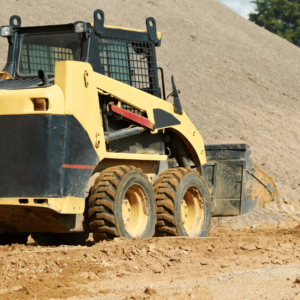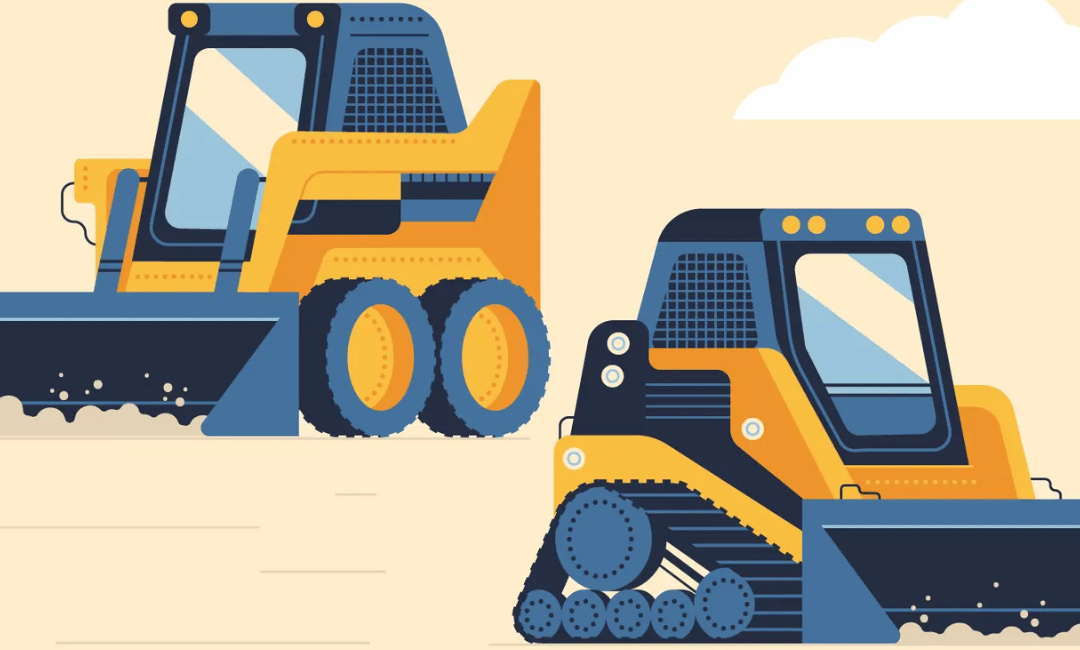Two of the most often used compact construction equipment are skid steer loaders and track loaders. Essential for many businesses, including construction, landscaping, agriculture, and material handling, both machines provide outstanding flexibility, power, and compatibility with many accessories.
But deciding between a skid steer loader and a track loader comes down to topography, job requirements, running expenses, and upkeep among other things. This tutorial will thoroughly compare both machines to enable you to decide which one best fits your needs.

1. Understanding Skid Steer Loaders and Track Loaders
What is a Skid Steer Loader?
Running multiple attachments utilizing hydraulic power, a skid steer loader is a small, wheeled vehicle. Its unique steering system lets it “skid” and turn in place by having the wheels on one side travel at different speed than the other.
Key Features of Skid Steer Loaders:
- Wheeled design gives quicker speed and mobility on harsh routes.
- Excellent for small area operation is a tight turning radius.
- Supporting buckets, augers, grabs, trenchers, and more is flexible attachments.
What is a Track Loader?
Though it rides on rubber or steel tracks instead of wheels, a track loader—also known as a compact track loader (CTL—is like a skid steer. Its design gives better traction and stability especially on uneven or gritty ground.
Key Characteristics of Track Loaders:
- Improved grip and less ground disturbance help tracked design to be popular.
- Great stability on hills and muddy ground.
- Perfect for activities requiring extra force and traction, heavy-duty performance is
2. Key Differences Between Skid Steer Loaders and Track Loaders
| Feature | Skid Steer Loader | Track Loader |
|---|---|---|
| Mobility | More quickly on paved, hard surfaces. | Slower but better on rough terrain |
| Traction | Less on uneven or mushy ground | Superior grip on muddy, sandy, and uneven terrain |
| Ground Impact | Greater ground pressure may degrade surfaces. | Lower ground pressure, minimizes soil disturbance |
| Operating Costs | Reduced beginning cost and upkeep | Higher initial cost and track maintenance |
| Versatility | performs effectively with several attachments. | Supports the same attachments but handles rougher conditions better |
| Durability | Wheels lose less but can become caught in soft ground. | Tracks are more durable but wear faster on hard surfaces |
3. When to Choose a Skid Steer Loader
1.You work on hard surfaces, even, paved ones.
On concrete, asphalt, or hard ground, skid steer loaders shine. Their wheeled design allows them to go quickly without excessively wearing down.
2. You need high speed and manuversability.
If your work involves regular travel between job sites, a skid steer loader is a better option since it moves faster than a track loader.
3. You Want Low Maintenance and Initial Outfits Costs
Skid steers typically start at less and require less maintenance since wheels are less expensive to fix than rubber tracks.
4. You share a close quarters workplace.
Close turning radius of a skid steer helps small building sites, interior operations, and limited places.
Best Uses for Skid Steer Loaders
- Roads’ asphalt paving and maintenance
- indoor destruction
- Handling materials in a warehouse
- Groundwork for a solid ground landscaping project
4. When should one decide on a track loader?
1.You work on soft, sloping, uneven ground.
Excellent traction and stability on muddy, sandy, or sloped ground is perfect for rough task sites track loaders.
2. You Need More Ability for Power and Heavy Lifting.
Because they frequently have stronger hydraulics and more running capacity, track loaders are more suited for heavy-duty tasks such grading and excavation.
3. You Want to Reduce Ground Movement
Whether your operation covers sensitive regions, golf courses, or lawns, a track loader’s lower ground pressure helps prevent soil damage.
4. You Need Continuous Performance.
Track loaders better than skid steers at managing snow, mud, and wet conditions; more suited for year-round operations.
Best Applications for Track Loaders: Excavation and grading
- Working under snowy or muddy conditions
- Forest management and land clearance
- Operations in agriculture
5. Cost Comparison: Skid Steer vs. Track Loader
- Skid steer loader: $360,00 to $10,000 purchase cost
- Loader for Tracks: fifty thousand to one hundred thousand
Maintenance’s Costs:
- Reduced maintenance costs; in a skid steer loader, wheels last longer and are less expensive to repair.
- Higher maintenance costs; tracks deteriorate more quickly—particularly on rough surfaces.
Track loaders ;Managing Expenses:
- Skid Steer Loaders use less fuel and ask for less repairs.
- In a track loader, regular track changes and higher fuel use drive costs.
6. Which Machine Is Best for Your Business?
Choose a Skid Steer Loader If:
✅You labor on asphalt or concrete, a hard surface.
✅You want a machine that goes swiftly between places.
✅You want to cut expenses for upkeep.
✅ Your task calls for close space navigation.
Choose a Track Loader If:
✅ You cover sloping, sandy, or muddy ground.
✅You need a machine more in line with stability and traction.
✅ You want to minimize ground damage.
✅ You require a machine that performs well in all weather conditions.
7. Can You Use the Same Attachments on Both?
Yes! Both skid steer loaders and track loaders support a wide range of attachments, including:
- Buckets (general purpose, rock, or grapple)
- Augers (for drilling holes)
- Trenchers (for digging trenches)
- Brush Cutters (for clearing land)
- Pallet Forks (for material handling)
However, track loaders may handle heavy-duty attachments better due to their hydraulic power and stability.
8. In Summary
Powerful devices with special advantages are skid steer loaders and track loaders. Your decision will rely on your working site conditions, workload, budget, and long-term operational requirements.
- A skid steer loader is the best option if you need a quick, reasonably priced machine and work on paved or hard surfaces.
- A track loader is the best purchase if you need great traction and stability and work on soft, uneven, or bumpy ground.
Analyze your particular work conditions, budget, and attachment demands to choose which machine best fits your needs before deciding on a final one.




